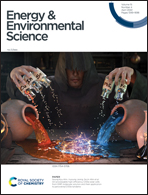An anticorrosive zinc metal anode with ultra-long cycle life over one year†
Abstract
Metallic zinc has been considered an ideal anode material in aqueous Zn-based batteries due to its high capacity and low redox potential. In addition to dendrites, Zn anodes suffer an additional threat from the inevitable hydrogen evolution reaction (HER) that occurs during the electrochemical process. This HER issue plays a rather insidious role in decreasing the performance of Zn anodes and has not yet been clearly elucidated. Herein, the suppression of HER is achieved by modifying the Zn anode with indium, enabling an ultra-dense and rock-like plating morphology without the formation of zinc hydroxide sulfate hydrate. Through detailed observations using scanning electron microscopy, the relationship between morphology evolution and HER under different current densities and during cycling has been highlighted. Additionally, both reduced polarizations for Zn plating and stripping are achieved after modification. Very impressively, the cycle life of the Zn symmetric cell is dramatically improved from 70 h to over 1 year (>9000 h) after indium modification. The full cells coupled with MnO2 cathodes can deliver 250 mA h g−1 after 300 cycles with a capacity retention of 99%. This work reveals that the suppression of HER is a significant route to promote the performance of Zn anodes.



 Please wait while we load your content...
Please wait while we load your content...